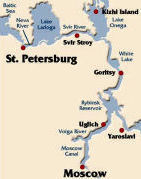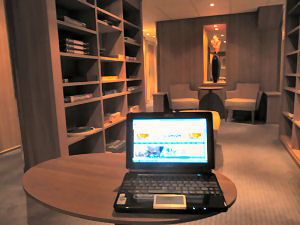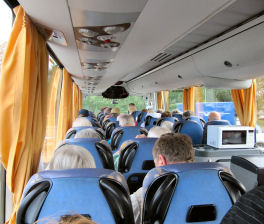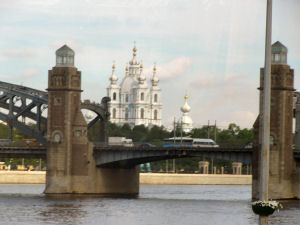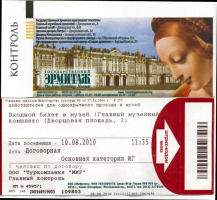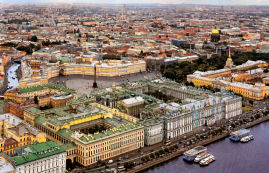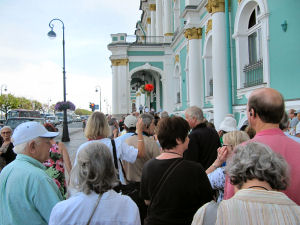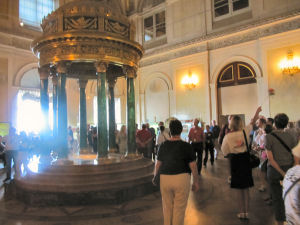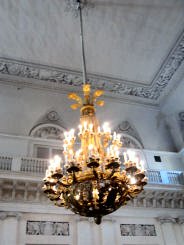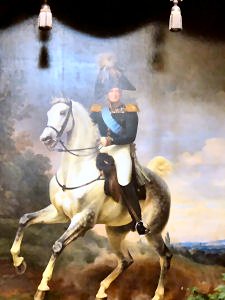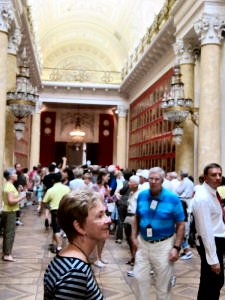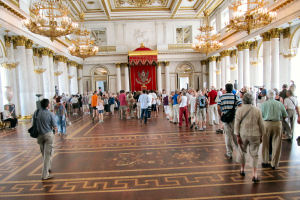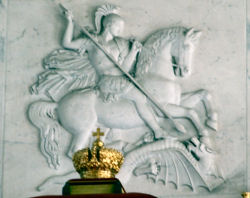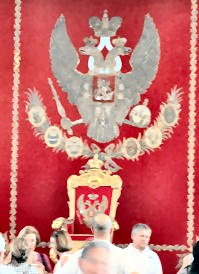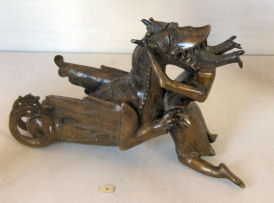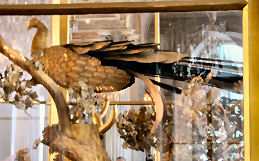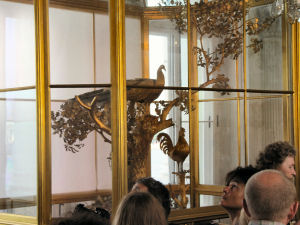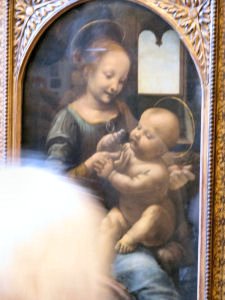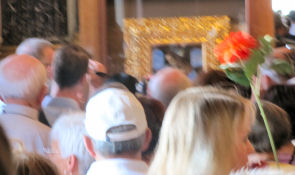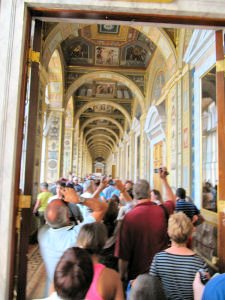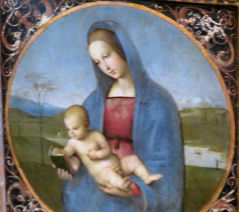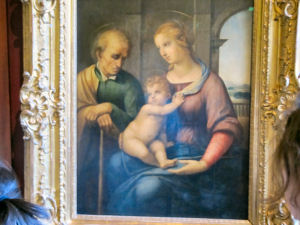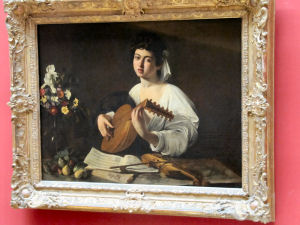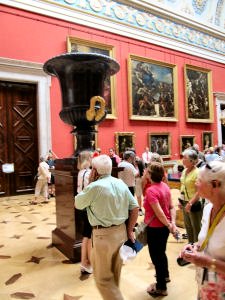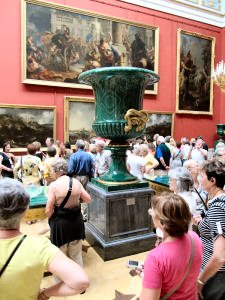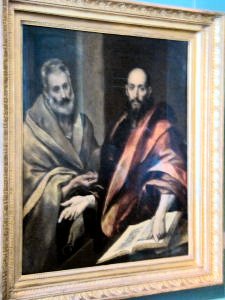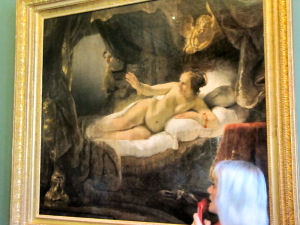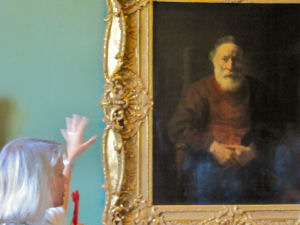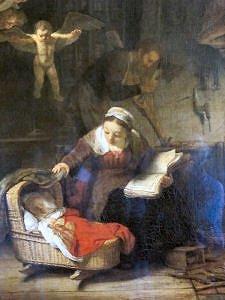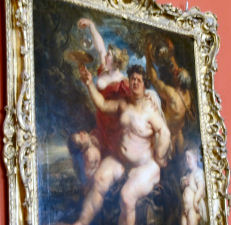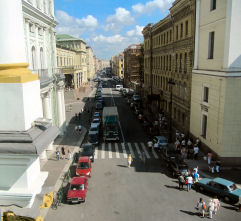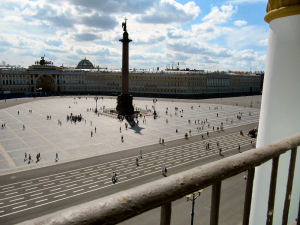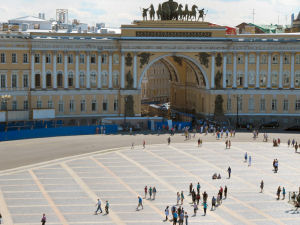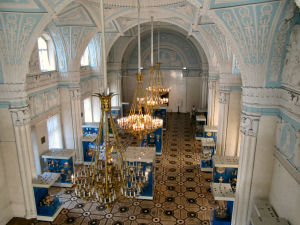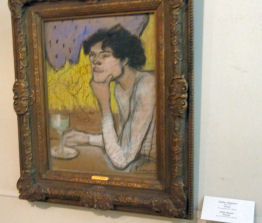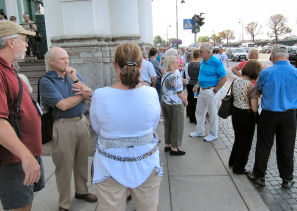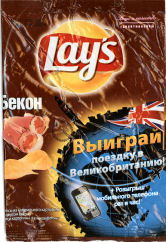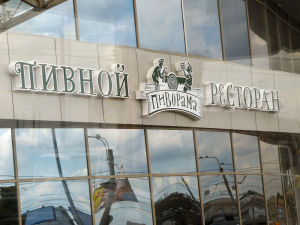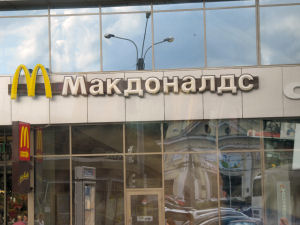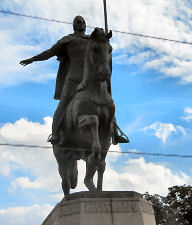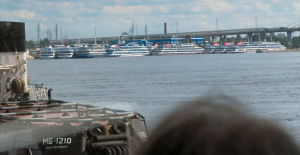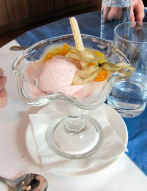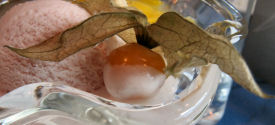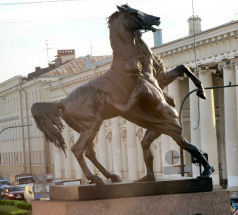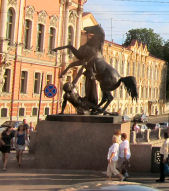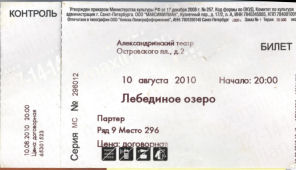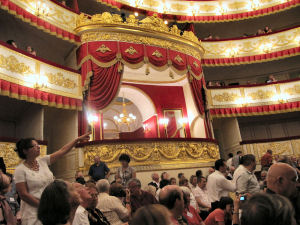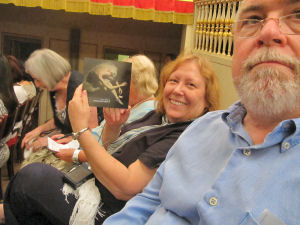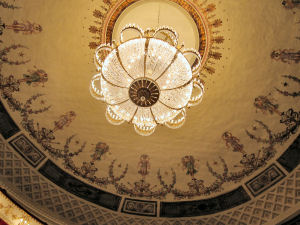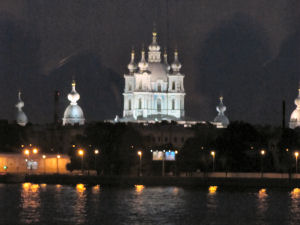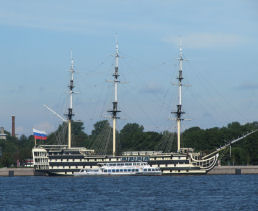
My right knee appeared to be a little swollen.[2] I resolved to try to be careful to stretch my I-T band whenever I had a chance. The long plane ride seemed to have bothered the knee a little, but stretching has always been sufficient in the past.
We ate breakfast with Corcorans. The ship’s restaurant was situated on our deck on the aft end of the ship. We went to the far side, which had a much better view. Breakfast on the ship was always administered buffet style. They had cocktail sausages, non-crisp bacon, and scrambled eggs, which, for my taste were a little too cold and not quite firm enough. They also offered boiled eggs, several types of cereal, cold cuts, bread, a selection of juices, and coffee. There was one tricky thing – the two sides of the serving line were not identical. The hot meat was on one side; the eggs were on the other.
Even a curmudgeon like myself would never complain about the ship’s breakfasts. Our waitress on that first morning was named Irina. We later deduced that the wait staff patrolled the same set of tables every day.Sue insisted at breakfast that she was pretty sure that the agent had included the unlimited drinks package as part of what we had paid for when she negotiated this back in December and January. Maybe so, but she did not have anything in writing.
All four of us decided to signed up for the Cossack show and the tour of Peterhof Palace. Sue and Patti wanted to go on the canal cruise and to try their hands at матрёшка painting. Tom and I opted for the shuttle bus. We did not know what we wanted to do, but this was one of the very few opportunities that we would have to explore the city on our own. Tom said that his contacts who tended the bars had told him that the best place for Internet reception was in the library, which was located behind the reception desk on the deck below ours. I went down to try it out. It was a little better, but the lack of bandwidth still rendered it barely tolerable. Everyone seemed to be complaining about the inability to get online. The library had a reasonable selection of books as well as backgammon, Trivial Pursuit, Scrabble, and three copies of some German game (or maybe set of games) that I had never heard of. It also had several dice trays. Sue and I have long had one complaint about the Asus eee Netbook that was on its second trip. If you pressed a key even a little bit too hard, it displayed the letter twice. We had yet to figure out how to avoid this annoying feature. Sue attended the ship’s safety briefing. I don’t recall that she ever told me what she learned. Half of this trip would be in lakes and canals. How much trouble could we possibly get into?Our first tour was of the Hermitage. The established drill on the ship was to turn in the key card every time that we disembarked. We traded this for a little card that had our name and cabin number on one side and the address of Viking’s pier in St. Petersburg on the other. Konstantin had assured us that this, not our passport, was what was required for identification in Russia. We wondered how many people in the gulag had been given the same assurance.
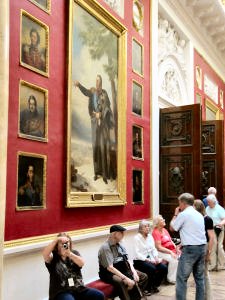
Polina was a fountain of information. She informed us that there were currently 142 million people in Russia. It currently stretched over eleven time zones, but eventually the number would be pared down to nine. One-third of the country, the largest by far in the world, is covered by timber. Moscow was by far the largest city, with 11 million people. She said that St. Petersburg had 4.2 million people. For some reason St. Petersburg did not seem that big to me and my fellow travelers, but Wikipedia said that the figure was actually 4.6 million. Russia had a population problem, but not the same kind that other countries faced. The population was actually decreasing by approximately seven hundred thousand per year.
Russia’s weather during the summer of 2010 had been disastrous. Four hundred thousand hectares of land had been lost to fire. Three hundred sixty new fires were being reported each day. The weather on this day, in St. Petersburg at least, went from cool and rainy in the morning to warm and sunny in the late afternoon. St. Petersburg was founded in 1703 by the Romanov czar, Peter I (the Great) during the war with Sweden. The city was surrounded by swamps and marshes. The climate[3] by anyone’s standard was horrible. The average year contained only sixty sunny days, one hundred forty-three rainy days, and one hundred twenty-six days below freezing. St. Petersburg is seven hundred kilometers from the Arctic Circle. The growing season only lasted from June to August. They had to import much of their food. Ironically, most of it came from Scandinavia, which, although even farther north, is warmed by the ocean currents. Since the city was founded, horrendous floods have come every October. Embankments and canals were constructed to prevent the floods, and that has dealt with the problem.Czar Peter I had started a war with King Karl I of Sweden in order to get a port on the Baltic. Peter finally prevailed in 1709. As hard as it is to believe, he declared St. Petersburg the capital in 1703 when it was still held by the Swedes. After that he ordered his government employees to immigrate to St. Petersburg at the rate of forty thousand per year. In addition, ten thousand unpaid serfs were sent every year. The conditions were so bad that most of them died.
Officially the capital was moved to St. Petersburg in 1712. The city served as the final resting place for all of the czars. Even under the Soviets and the current government it enjoyed the “representative function” for the Russian government. Meetings with foreign diplomats were held in St. Petersburg. Some of the ministries were also in St. Petersburg.I recorded in my notebook that Polina said that Anna, a very unpopular empress, had brought the capital back to Moscow in the 1730’s. Wikipedia said that she spent most of her time in Moscow, but she did not move the capital. I probably misunderstood.
In the 1770’s everything European was in fashion among the nobility in Russia. Some of them even sent their laundry to Paris for cleaning. It was considered bad form in the upper tiers to wear the same dress twice. At parties women made a habit of deliberately pouring a little champaign on their clothes to prove that they had not been worn twice. Evidently the detergents of the day were no match for champaign stains. We saw the first of many newlywed couples having their photo taken. Marriage was very popular in Russia, but so was divorce. Polina said that the divorce rate in the country was 60 percent.[4]In 1918 the Bolsheviks moved most of the governmental functions from St. Petersburg to Moscow. The city was officially called Petrograd from 1914 to 1934. The name was then changed to Leningrad in 1934. After the fall of the Soviets in 1991, the citizenry voted to change the name of the city back to St. Petersburg, but the people living on the outskirts of town mostly voted for Leningrad. In fact, the region (область) is still called Leningrad.
Polina went through the entire list of Romanov czars with no trouble at all. Konstantin had said that they were “a little like the Simpsons, but they ruled our country.” Polina repeatedly said that 80 percent of the tax money goes to Moscow. She also said that in World War II, which the Russians call “the Great Patriotic War,” Leningrad was under siege by the Germans for 900 days.The local legend claimed that St. Petersburg was founded by the apostle Andrew. Polina did not try to convince us of the veracity of that preposterous idea, but she did say that the area was certainly inhabited by the fifth century.
The Neva River, which is the main waterway in St. Petersburg is actually a strait between the Gulf of Finland and Lake Ladoga, the largest lake in Europe. The river contains fresh water, as does most of the Gulf of Finland.
The Winter Palace was built in 1732 for Empress Elizabeth, whose reign was termed “the never-ending masquerade.” She loved luxury and was devoted to her personal appearance. She allegedly spent more on clothes than on her palaces. Nevertheless, each window in the Winter Palace cost the equivalent of five-years wages, and each door ten-years wages.The Winter Palace has always served as the main building of the Hermitage, which was named by Katherine II (the Great). By 2010 the museum had expanded to include four other adjacent buildings as well. 15 percent of the total collection, which was based on the artworks amassed by the Yusupov family, was on display.
We entered the Hermitage through a special entrance reserved to tour groups. We had to go through security, but it did not seem to be very strict. Polina is a resident of St. Petersburg, and a registered guide for the city. So she was allowed to conduct the tour herself. We were outfitted with ear pieces and small receivers bearing our bus number that we wore around our necks. It was not dissimilar to the arrangement that was used when we toured the Louvre in 2009. After we climbed the staircase, which was under construction, we assembled around an elegant gazebo with green columns. Polina said that it was just a decoration.I noticed that IBM made this part of the planet a little smarter by providing the electronic visitors' guide in the Hermitage.
The Winter Palace suffered a fire on December 17, 1837, during the reign of Nicholas I. According to Polina only two objects went missing. She said that something or other made of silver was later returned. Two gold earrings were found in the snow.
Katherine the Great pulled down all of the baroque decorations that Elizabeth had installed in the buildings and replaced everything with classical architecture.Alexander Nevsky won two great battles in the middle of the thirteenth centuries. In one of them he tricked the Prussians into bringing their cavalry onto the ice in pursuit of his troops. No Russian soldiers were lost in that battle. Nevsky was subsequently named[6] a saint. “Nevsky” is an epithet that he received from his first victory over the Swedes on the Neva River.
Polina told us that in 1812 Czar Alexander I defeated Napoleon.[7]The St. George[8] Room contained Empress Anna’s throne. The floor in this room has the same pattern as the ceiling. The two-headed eagle is the symbol of Russia. It looks to both the east and the west.
The cannon of the Peter and Paul fortress across the river has always fired every day at noon. We heard it
Germany bombed Leningrad extensively during the siege, but the Hermitage was mostly spared because Hitler wanted to preserve the artistic treasures in it for his own benefit.The Pavilion Hall contained the huge and splendid peacock clock. It was taken apart and reassembled three times by its designer James Cox in the eighteenth century. It was still functioning in 2010.
The Italian rooms of the Hermitage displayed a sample of the one hundred thousand paintings from that country that it owned. All together there were more than a thousand rooms in the museum.Two of the twelve extant paintings by Leonardo da Vinci were on display. The Benois Madonna was brought to Russia by a wandering musician. Leonardo did not sign it. Czar Alexander II acquired the Madonna Litta from Count Litta.
The Raphael Loggias were a replica of Raphael’s huge work commissioned by Pope Leo X. Fourteen Russian artists were dispatched to Rome to study the gallery. It then took them seven years to complete the work, which was probably longer than it took Raphael and his students to create the original.Raphael’s Madonna Conestabile was painstakingly transferred from wood to canvas by a complicated process. It was in very poor condition at the time.
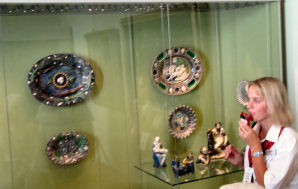
We stopped for a few minutes at Antonio Canova’s statue of Cupid and Psyche. My familiarity with Canova was previously limited to the outlandish tombs that he had created in Italy.
I was very surprised to see a painting with which I was already well acquainted, Carlo Maratti’s portrait of Pope Clement IX.[9] I even included this painting in the online version of my work on the popes. I had to wonder how in the world this painting got into the Hermitage.[10]The Spanish rooms of the Hermitage feature a sizeable portion of the one hundred and fifty Spanish paintings. Polina identified Velasquez as the fellow in yellow in his painting of three men at a table, The Luncheon.
Goya’s portrait of Antonia Zarate was a gift of Armand Hammer in the sixties. He received plenty in return. The Soviets[11] sold much of the czarist treasures to their favorite westerners at bargain basement prices, including several crowns, the crown jewels, and all of the furniture. They sold the entire library of Nicholas II, including the oldest existing copy of the Koran. I could swear that Polina said that it dated back to the sixth century, which would, of course, be impossible. I could find nothing about this on the web. Maybe she said “sixteenth century.” El Greco’s painting of The Apostles Peter and Paul was very interesting for its political implications. Paul definitely appeared dominant. I could see why this would be popular in an orthodox country that harbored a distrust of the popes, who have claimed to inherit their authority from St. Peter, who is considered the first pope.We spent a good deal of time admiring Rembrandt’s big painting of Danaë. He used his wife as a model.[12] In 1985 a Lithuanian splashed sulphurous acid on it. Although he had been committed to an asylum for sex crimes, he had subsequently been released, and in 2010 he was evidently free. The name of the assailant was for some reason never released. The painting was 27 percent destroyed, but it is still considered authentic because of the painstaking job of restoration, which was made possible because Rembrandt laid the paint on so thickly.
Rembrandt’s last painting was The Return of the Prodigal Son. I am pretty sure that the hands were important, but I do not remember why. I know that I tried to take several photos of them, but none was worthy of display. The Hermitage owns an astounding twenty-four Rembrandts. In the Tent Room (so called because of the shape of the ceiling) were innumerable small Dutch Masters. “Small” indicated the size of the paintings, not the quality of the artists. The museum’s Dutch collection is unmatched anywhere.The Hall of Rubens contained thirty-six of his paintings and drawings. It featured the world’s only portrayal of a sad-looking Bacchus. Perhaps he had just heard about vodka.
The dishes that were displayed in one glass case contained real snakes and frogs that had been enameled and placed in the bottom. Fruit or pastries were then served on top. It was great fun when one of the ladies noticed the critters lurking beneath.
Katherine the great died in the Corner Room.
Polina ended the tour by telling us that the Hermitage also contained fifteen rooms of impressionist paintings on the second (third to Americans) floor. Tom and I wandered around for a while pretending to look at the paintings. I took a photo of one Picasso and noticed a sign that indicated that one of the paintings had been donated by the Sara Lee Corporation. Sue had abandoned the tour earlier in search of cool fresh air.
After Tom and I had been through enough rooms that we had completely lost our bearings, we set out in search of a mens’ room. Tom asked many staff people “Где туалет?” Elaborate instructions involving any number of left turns ensued. After a lengthy journey we passed an exit, which I suggested that we should take advantage of. We continued on and finally found the W.C., which was tucked away in an obscure hallway far removed from everything.Now we had to locate the lobby, which was where Polina had asked us to meet her. We had very little idea where we were, and the place was absolutely gigantic. I asked an elderly gentleman who was seated, which presumably meant that he was an employee, “Извините, пожалуйста, где фое и выход?” I was pretty sure that this meant something close to “Excuse me, please, where is the lobby and the exit?” He immediately said, “Do you speak English, or perhaps German?” Then he gave us precise directions in impeccable English. We finally found it.
We ended up going out the same exit that we had passed earlier. As I suspected, there was a toilet right after the turnstile. I could hardly blame Tom for wanting to use the facility in the museum before we were irreparably separated from it. We were frustrated to discover that we could not reach the lobby from where we were. We could see Polina waving her red flower, and we could hear her over our earphones, but we could not join her in the lobby. We did, however, find the bankomat, and I used it to obtain four thousand rubles.[13] I made the rookie mistake of asking for a round number, and the machine gave me four one-thousand-ruble notes.In the end we just went out the nearby door with the intention of joining the group outside. We were pleased and surprised to find Sue on the portico along with a few other members of our group. Polina soon led another bunch toward our location.
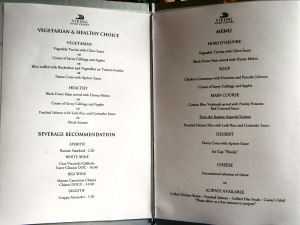
The Hermitage was an overwhelming experience for jet-lagged tourists. It was tremendous, but there was just too much to digest intelligently. Nothing in the museum affected me quite the way that the Davids and Delacroix’s did in the Louvre, but the Rembrandts came close. Besides, Polina’s emphasis was more on the historical than the artistic, and that suited me.
Polina provided us with a short introduction to the Romanov (ruh MAHN off) family, which ruled Russia up until 1917. In 1613 Michael Romanov was selected by the nobles to serve as the czar, which meant Caesar. Ivan the Terrible began using that title in 1547. The chaotic period between Ivan’s death and Michael’s coronation was known as “the Time of Troubles.” The dominant figure in the firsst part of that period was Boris Godunov.
Peter I ruled for ten years. His only son Alexei was convicted of treason and was sentenced to death. Peter never got around to naming an heir. He had married his first wife Eudacia at age 15. He later sent her to a convent. Peter was a very tall man, approximately 6'8". He died of the flu at age fifty-three after helping sailors in ice-cold water. Two daughters survived Peter, Anna and Elizabeth.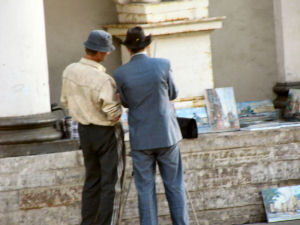
Approximately one hundred sixty descendants of the Romanovs survive. The only one who was active in politics was Paul Ilyinski, the mayor of Palm Beach from 1993 until 2000. He died in 2004.
Before 1812 the Russian nobility all spoke French. Napoleon’s invasion of Russia made them think better of that practice. The later Romanovs loved the writings of Sir Walter Scott, whom they considered Europe’s last knight.
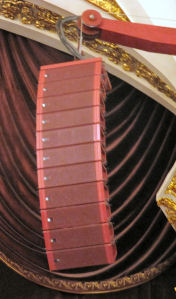
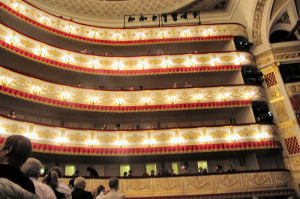
For supper I ordered the salmon over rice with leeks. The starter was ham with melons. There were two kinds of melons. The thinly sliced ones were very good. I would never consider ordering cabbage soup anywhere else, but it seemed appropriate here. It was not bad. Our waitress Julia (Юлия in Russian) asked someone in the kitchen what the vegetable that accompanied the salmon was. There was also something on top. The dessert was an unexceptional panna cotta. Sue had the veal cordon bleu and did not think much of it. Tom and Patti both got the “always available” steak and regretted it. Patti was faked out by its designation as a filet.
After supper we all got back on the buses to attend a ballet at the Alexandrinsky Imperial Ballet Theatre. I had packed a sports jacket, and it did not appear to be in too bad a condition. Even though the weather was a little hot, and we were warned that the theater was not air conditioned, I was determined to wear it.
The ballet being performed was Tchaikovsky’s[14] Swan Lake – Лебединое Озеро. Polina told us that this was not the top-rated ballet company in town. Even a Philistine like myself had heard of the Kirov Ballet Company and the Mariinsky Theater. Romantic music – Brahms, Tchaikovsky, and the like – had always tended to put me to sleep, and my interest in dance was nil. In fact, this was my first ballet. My goal was to get through the performance without excessive snoring.Our seats were in the ninth row right in the middle. This would be the ideal location if we were attending an opera. There were three intermissions. I dozed off at least once in each act. At one point in the third act I could have sworn that an elaborate headdress worn by one of the secondary cast members had morphed into the mouth of a small cannon.
I do not know her name, but the prima ballerina impressed everyone. The jester also seemed very athletic and supple. The rest of the cast did not excite me, but I have no credentials for judging any dance performance.No photos were allowed during the performance. The weirdest thing about the evening was the curtain call. Only the people who were onstage for the silly final scene were involved. None of the performers from earlier acts appeared. Maybe everyone else had already gone home.
The theater was reminiscent of the one in which we had attended The Marriage of Figaro in Prague in 2007. In fact, the layout seemed virtually identical.On the bus trip back to the ship Polina related a joke that had reportedly been told to her by a Mormon missionary. Nikolai Rimsky-Korsakov went to visit Tchaikovsky’s grave to pay tribute to him on the anniversary of his death. He was surprised to find the maestro sitting up with a pile of his scores in front of him. He was busily erasing notes on a sheet with Swan Lake written in bold print at the top.
Rimsky-Korsakov was shocked. “Pyotr Ilyich,” he cried. “I cannot believe my eyes. What are you doing?”Tchaikovsky looked up at him and nonchalantly replied, “I am just decomposing.”
Sue and I first heard this joke – with the starring roles played by Beethoven and Mozart – in Ann Arbor, MI, in 1976. It was told by the lead singer of a rowdy bluegrass group called the Red Mountain String Band.[15]
As soon as Sue and I had descended from the bus, I told Polina how old the joke was. She seemed surprised, but she blamed the Mormon.
When I got back to the cabin, I collapsed of exhaustion in my bed. The first full day in Russia was certainly jam-packed with meaningful experiences.
[1] Our experience with weather on our European vacations had been phenomenal. Because I recorded the weather in my journals, I was positive that we had not experienced what I would deem bad weather on any of our last five trips, a total of approximately thirteen weeks. I may be mistaken, but I think that the weather on the two previous trips was also unexceptionable. It rained a few times, of course, but generally we were en route or inside. Never had an activity been affected by the weather.
[2] Back in the seventies I broke my kneecap, and it started to bother me in the nineties. A therapist then provided me with a set of exercises to keep it stretched.
[3] I generally use the past tense in these journals. I do not mean to imply that the climate has improved.
[4] I tried to look this up. The rates quoted for Russia on the Internet range from 40 to 65 percent.
[5] I was very surprised to discover that his last three big triumphs were in Italy, of all places. I had never come across this information before, and I had read quite a bit of Italian history.
[6] I hesitate to use the word “canonize.” I don’t think that the Russian Church has anything equivalent to the Roman canon. There certainly is no one with the authority of the pope. The process by which someone becomes a saint seems to be somewhat less rigid.
[7] Napoleon marched all the way to a deserted Moscow without being seriously engaged by the Russian army. The Grande Armée was subsequently brought a cropper not by the valor of the Russian soldiers but by the scorched earth tactics devised by Karl Ludwig von Phull and employed by the Russian people. Napoleon expected Alexander to surrender when Moscow fell, but the czar stayed in St. Petersburg.
[8] I have never understood the attraction of this saint. The only thing that anyone knows about him is that he slew a dragon. No one except overnight radio listeners believes in dragons, but the cult of St. George continues to thrive.
[9] One of the most interesting of all the popes. He wrote the libretto for the first comic opera.
[10] I still do not know. The Hermitage’s website does not include the provenance of this work.
[11] By 2010 the term “Communist” in Russia seemed to be reserved for members of the Communist Party that regularly received a few per cent of the votes in Russian elections.
